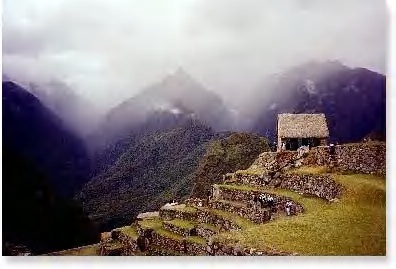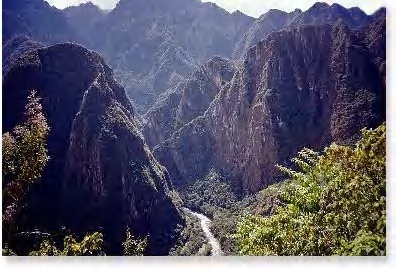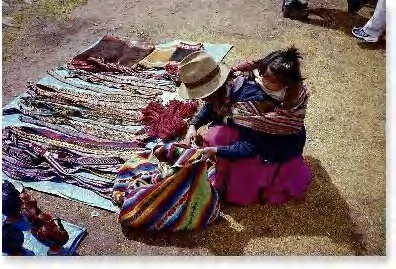THE LOST CITY OF THE
I N C A S
It's nice when getting there is half the fun. For Hiram Bingham the third, it wasn't.
In 1911, the 36-year-old American adventurer was hacking his way through the jungles of the Peruvian Andes heading for what the local Indians called simply, "Old Mountain." At the top lay what he hoped was the final refuge of Manco Inca, the leader of an unsuccessful rebellion against the Spanish conquistadors in the early 1500's.
According to guide, Leylis Gutierrez, "Bingham's party met a family that was farming the terraces. 'How are you?' his Indian guides said to them. 'We haven't seen you in a long time.' So there they were talking together and nobody was paying attention to Hiram Bingham. Finally a little boy, maybe 8 or 9, led him to the ruins. What he saw was a single temple poking out of a dense overgrowth of trees."
"I know of no place in the world which can compare with it," Bingham wrote later. "Not only has it great snow peaks looming above the clouds more than two miles overhead, gigantic precipices of many-colored granite rising sheer for thousands of feet above the foaming, glistening, roaring rapids; it has also, in striking contrast, orchids and tree ferns, the delectable beauty of luxurious vegetation, and the mysterious witchery of the jungle."
If Bingham's trek was arduous, he was rewarded with the prize of a lifetime. Nearly a hundred years later, the routes to Machu Picchu are rewards in themselves. The most famous, the Inca Trail, entails high mountain hiking through spectacular passes and overnighting in tents at designated rest stops. Yet the name implies that it was the only Inca trail. At the height of their glory 14,000 miles of roads and trails linked the rulers in Cuzco to subjects in an empire that extended 2.500 miles from Columbia to Chile. There was indeed more than one Inca Trail.
For those uninclined to hoof it, trains leave Cuzco several times daily, arriving at the village of Aquas
Calientes at the foot of the mountain in 3 to 4 hours. One, the aptly named Hiram Bingham, is a luxury train limited to 84 passengers who are wined and dined and transferred to and from the ruins which they can explore after most tourists have left. And there are more than enough tour operators ready and willing to organize a trip to the site. Some of these are reputable, some less so, and a very few exceptional. Abercrombie and Kent is one of the best of these.
A & K's "Inca Adventure" starts in Lima, glances off Cuzco, the high altitude capital of the Incas, and gets up to speed at the Posada del Inca Yucay. The Posada is a Sonesta hotel of multi-colored buildings with overhanging balconies. Below them is a patio with a small church on one side, its towers painted bright yellow, the remainder a deep salmon. Around a fountain garlanded with flowers Indian ladies in colorful skirts and blouses lay sweaters and serapes and rugs. As we watched, one woman stripped off her native outfit. Underneath she wore smart contemporary clothes, turning in an instant into a modern suburban housewife.
The Posada del Inca Yucay is situated near the center of the Sacred Valley, so-named because of its extraordinary fertility. Using the hotel as a base, the remains of Inca villages and temples can easily be explored.
With A & K guides, Miguel Arce (Basque and Irish) and Leylis ("My heart is 100% Indian"), our driver expertly piloted a large bus to the town of Chinceros. We found it on a vast plateau surrounded by rugged
cliffs draped with glaciers. Beautiful terraces still farmed after hundreds of years enfolded the town. Steep cobblestone streets literally took our breath away. Every inch of the interior of the Spanish church, built on Inca walls, was covered with frescoes, hung with paintings and adorned with statues.
Not far from Chinceros, Maras is a town of brown adobe bricks made from the earth on which it stands. We took lunch there on a small grass field at two round tables set with wine glasses and silver. A buffet of fresh cold salads, hot meats and vegetables and several home made desserts was served by friendly, soft-spoken waiters. The views of the Andes were magnificent if you didn't mind the high tension wires. We didn't. It was roughing it, Abercrombie & Kent style.
After lunch we walked a farmers' path along deep gorges where tiny terraces had recently been plowed. Starting under a brilliant sun, the weather turned in minutes to a somber overcast, to light sprinkles and back to sun again. As we descended, the trail and gorge narrowed. Suddenly in the distance we saw what looked like a sprawling white beehive cascading down the cliff. As we approached, the cells broke into shallow pools divided by salt-encrusted walls. Leylis explained that these salt pans had been mined since Inca times, the source a mineral spring in the mountains. Local families still harvested pans that had belonged to them for generations, a total, according to the community leader, of 5,000 extending far into the valley. A woman was bending over in one of the pans, breaking off the salt. Men gathered it into bags which they lugged on their shoulders to dry land. We walked uncertainly above them along a narrow trail while the Indians toiled in a surrealistic scene of incredible beauty.
From the posada we saw other Inca sites, though none as stunning as this. In Ollantaytambo we were invited into a house where dozens of pet guinea pigs scurried over the floor. Pets now, dinner later. Another day we hiked in the rain past burial niches carved into a cliff. The male contingent rafted the rapids of the Urubamba River. But this was just a warm up for the full day hike to Machu Picchu.
An early morning wakeup call, a farewell buffet breakfast at the posada and a train ride to the trailhead found us crossing a footbridge to the Chachabamba ruins. Soon after, the valley was squeezed tight by high rock walls. Foliage became greener and taller, the path edged by meticulously placed stones rising and falling through ferns, orchids, vines and moss-hung trees. Below us the river tumbled over an almost unbroken series of rapids.
For an hour we climbed through the jungle until the Urubamba was a white-scaled snake slithering beneath our feet. Up we went, stopping to catch our breaths and to gape at the gnarled forest plummeting out of sight. Above us peaks disappeared in shifting mists. On one of them was Winay Wayna.
In the curve of a high mountain, rows of terraced fields dropped like an amphitheater until swallowed up by the jungle. Crowning the terraces, pointed walls rose like a castle in a fairy tale. After "discovering" Machu Picchu, Hiram Bingham went on to uncover the high Inca Trail. But he completely missed Winay Wayna which wasn't found until 1941. Scrambling upward we reached the temple and royal buildings made with interlocking boulders that fit so perfectly the thinnest blade couldn't be inserted between them.
After lunch we merged with the high Inca Trail, for the first time joining other pilgrims. The trail was paved, but where the stones had once been flat and smooth, now they were broken and ragged. For an
hour and a half more we labored toward our goal, the famous Sun Gate from which we would make our descent to the "Lost City." When we stepped through the stone pillars Miguel was waiting with congratulations and a bottle of champagne.
The trail ended at a small house perched at the top of the city's agricultural terraces. Dropping onto anything we could sit on, we gazed at a maze of inter-connected houses, long staircases and broad plazas. Like a gigantic condor's nest, Machu Picchu sprawled between the peaks to the edge of a cliff that dropped like a knife to the river. Finally succumbing to fatique and the promise of a hot shower, we walked slowly to our hotel.
The only accommodation situated directly at the site. The Machu Picchu Sanctuary Lodge is a long, low building of stone and earth colors. Its 31 rooms are compact and handsome, very comfortable and impeccably kept. Soothing creamy yellow walls are set off by rich dark furniture. The views of the
mountains above Machu Picchu, stupendous.
Before dinner we were issued flashlights and led into Machu Picchu through dark stone alleyways to an building that had been thatch-roofed to show how the city had once looked. Waiting for us was a woman who introduced herself as a spiritual leader of the ancient religion still practiced throughout the Andes.
For an hour she explained the Indian reverence for Mother Earth, the supreme deity. Bit by bit she put tiny portions of grain, the petals of flowers, a piece of money, bright beads, cocoa leaves and many more symbols of the essentials of life in a cloth on the dirt floor. She wrapped the pile and said she would burn it the next day and bury the ashes. The wishes she had instructed us to make would, she hoped, be fulfilled. When the ceremony was done we walked under a full moon back to our hotel.
Early the next morning Machu Picchu was swathed in mist. Mountains thrust out of the valley like fat green thumbs. As guests of The Sanctuary Lodge, Machu Picchu was ours alone until the first bus arrived. When it did we joined the late sleepers for breakfast at the hotel. Then we followed Leylis for a morning tour of the ruins.
Very slowly, as befit the site, he led us through the city, starting with the royal apartments and temple areas. Beneath them five-foot high stone walls supported strips of arable land that hung over the valley. "You see how perfectly safe the terraces are," he said. "Right," someone answered. "The terraces are safe. It was the farmers whose lives were in danger."
After the tour, Leylis left us to wander our own ways. Mine was from the lowest terrace to the highest temple, from Huyana Picchu, the tall mountain at one end to the Inca Trail at the other. I took time to study more closely the remarkable masonry, to walk slowly from room to roofless room, to watch the play of mist on the heights that were the Incas' constant companions.
It was mid-afternoon when we took the train to Cuzco. After our days in the countryside, the small city seemed like a bursting metropolis. Negotiating the narrow streets, our bus driver pulled up at a pristine white building with a massive arched entry. Through its glass doors was one of the most beautiful hotels in the world.
The Monasterio is a monastery not in name only. In fact, it is still owned by the Jesuits who lived there. In 1999, Orient Express Hotels turned its cloisters, its encircling balconies, its vaulting rooms and thick stone walls into something marvellous.
It's hard to know at the Monasterio what is original and what is not. The polished stone staircases have been smoothed by the steps of countless monks. The incredibly ornate chapel of San Antonio dates from 1650. Diners at the Illary Restaurant, perhaps the best in Cuzco, sit under ancient arches. But a wonderful stone fireplace in the lounge is new, though it seems of a piece with the rest.
Should there be any doubt, the rooms and suites, decorated in Spanish and Inca styles, are as modern as tomorrow. And the staff is as professional as it is friendly. 84 of the rooms can be supplied with an infusion of pure oxygen through the ventilation system, the effect being to lower the high altitude of Cuzco by over 3,000 feet.
We spent a day and two nights in Cuzco visiting its colorful squares and historical churches. On our own we walked a few blocks beyond the tourist area to the central market, a huge building segmented into meat, vegetable, flower, fruit, spice and other markets. We returned to the Monasterio for lunch in the cloister under a brilliant sun in the crisp mountain air.
Still our thoughts went back to Machu Picchu, a once-in-a-lifetime experience. I remembered several tourists on top of a small hill, eyes closed and hands laid reverently on a large smooth rock. "Many guides play with the feelings of the visitors," another guide was saying. "They tell them to meditate and feel the energy that comes from the mystical stones. For me," said the man who was the image of his Inca ancestors, "it's just a rock."
Machu Picchu had been fixed in my mind since I saw a photograph of it years ago. As for thousands of others, it had created in me an irresistible desire to journey to that city in the Andes. Now that I
was here I thought I knew what the guide meant. It isn't the stones that are magic. The magic is Machu Picchu.
ABERCROMBIE & KENT (800 323-7308, www.abercrombiekent.com) is perhaps the preeminent luxury tour operator in the U.S. Since 1962 the family-run organization has brought discerning travelers to over 100
countries in all 7 continents of the world, leading off-the-beaten-track excursions with comfort and style. They are the first international tour operator to have their own office in Peru.
GETTING THERE: LanChile (800 961-0056, www.lanchile.com) has for the past three years been named the Best Airline Based in Central/South America and the Caribbean in the Annual Official Airlines Guide.
LanChile's wine selection has repeatedly ranked among Business Traveler International's top 10 wine cellars in the air. LanChile offers a variety of non-stop and direct flights to Santiago, Lima, Buenos Aires, Bogota, Caracas, Quito, Guayaquil and Punta Cana, from its U.S. gateway cities of Miami, New York and Los Angeles, as well as from those cities offered through its codeshare partners, including Orlando. Limited to 5 passengers, LanChile's first class service includes completely flat sleeper-style seats. Business class consists of 28 - 36 spacious, ergonomically designed seats. Personal in-seat entertainment systems include video-on-demand, music-on-demand, computer games, eight movies on demand, as well as 12 music CDs on demand.
ACCOMMODATIONS: The Hotel Monasterio (800 223-6800 - booked through Leading Hotels of the World) and the Machu Picchu Sanctuary Lodge (212 302-5055) are members of the Orient-Express group of prestigious hotels and resorts (www.orient-express.com). Other fine properties are located in France, England, Spain, Italy, Portugal, Brazil, South Africa, Botswana, Australia and the United States.
The Posada del Inca Yucay (800 766-3782, www.sonesta.com) is a Sonesta hotel. Its "Posada Adventure" offers horseback riding, rafting on the Urubamba River, bike excursions and hiking in the Sacred Valley.
RECOMMENDED PACKING LIST: Weather can be cold or hot, dry or wet, so layers are the way to dress. Bring both long sleeve and t-shirts, jacket, long and short pants, swim suit, hat with brim, hiking boots, rain suit or poncho, toiletries, sun screen, sunglasses, insect repellent, medications, camera, film and passport. I brought convertible pants by Ex Officio, (800 644-7303, www.exofficio.com). When the weather warmed up the legs zipped off. Highly recommended. A complete packing list is provided by Abercrombie & Kent.
WHEN TO GO: Seasons in Peru are the opposite of ours. Our summer (their winter) is dry, warm during the day, cool in evening and popular with Americans and Europeans on summer vacation. Our winter (their summer) is wet and warm or hot and popular with South Americans on their summer vacations. One local's preference is just after the rainy season - April and May, when flowers are blooming and there are fewer crowds but an increased chance of short showers.
RECOMMENDED READING: "Explorer of Machu Picchu," by Alfred M. Bingham. "Lost City of the Incas," by Hiram Bingham.
PERURAIL'S HIRAM BINGHAM (www.perurail.com, ) is a new train carrying 84 passengers using carriages designed to reproduce the luxury of the 1920's Pullman era. Leaving at 9:00 AM, brunch and a round trip bus
ride and guided tour of Machu Picchu are included as is the afternoon tea buffet at the Sanctuary Lodge. The return train leaves at 6:30 after all other trains affording passengers the opportunity to explore Machu Picchu for four hours without crowds. Cocktails and a 5 course dinner with wine are served on the return.




